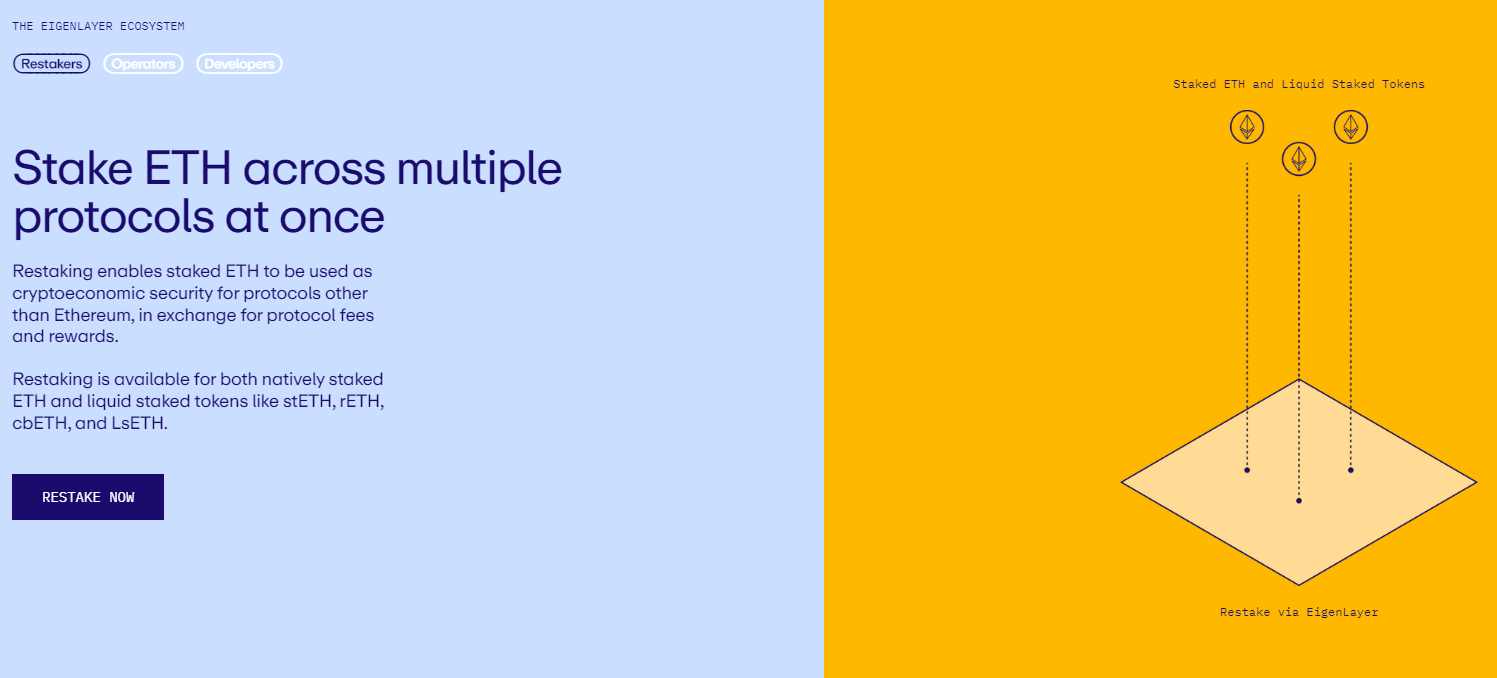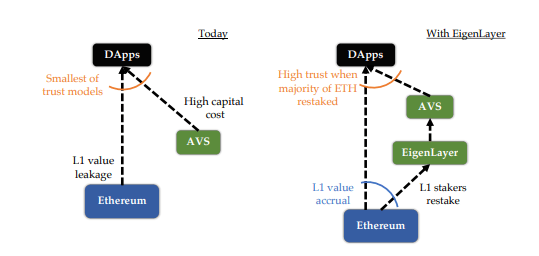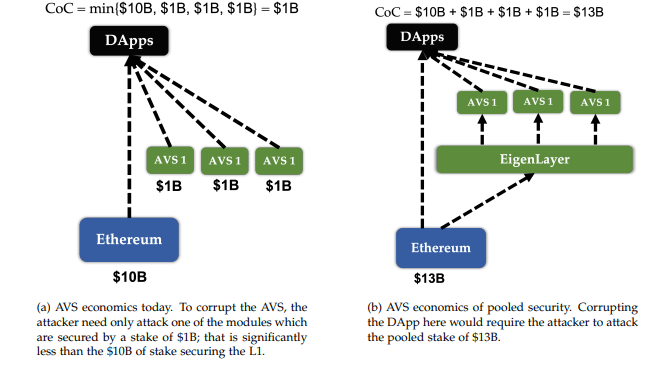In a domain driven by innovation, Eigenlayer is reshaping the staking landscape through a groundbreaking DeFi innovation known as Liquid Restaked Token (LRT)
What is Liquid Restaking Tokens (LRT)
Liquid Restaked Tokens (LRT) provide a solution by unleashing this liquidity potential and introducing an additional layer of leverage to enhance yields, Rather than depositing LST directly with Eigenlayer. Users have the option to deposit them through a Liquid Restaking protocol. This approach follows a similar rationale to the way to use Lido.
What is EigenLayer?

EigenLayer is an innovative protocol built on the Ethereum blockchain, introducing the concept of ‘restaking’. Restaking is a novel primitive in crypto-economic security, which allows for the reuse of staked ETH or liquid staking tokens (LST) on the consensus layer. By opting into EigenLayer smart contracts, users can restake their ETH or LST (e.g. fxsETH, rETH, or stETH), extending crypto-economic security to a variety of additional applications on the network and earning extra rewards in the process.
Ethereum stakers can help secure multiple services by restaking their already staked ETH, opting into numerous services at once, and providing pooled security. This not only reduces the capital costs for a staker to participate but also significantly increases the trust guarantees for individual services.
this protocol aims to solve the problem of fragmented security in decentralized applications built on Ethereum. It enables any service, regardless of its composition, to tap into the pooled security provided by Ethereum’s stakers, fostering an environment for permissionless innovation and free-market governance.
EigenLayer Innovation
EigenLayer offers numerous benefits to the Ethereum ecosystem, reshaping it in several impactful ways. Here’s an alternative presentation of these crucial points:
- Capital Cost Relief: serves as a catalyst for cost reduction by fostering collaboration and shared resources between Ethereum’s Layer 1 (L1) and Actively Validated Services (AVS). This opens up opportunities for ETH stakers to enhance their earnings by participating in staking activities on both the Beacon chain and AVS platforms.
- Profit Amplification: Through EigenLayer, ETH stakers can diversify their staking strategies, potentially increasing their profitability. This diversification enables them to tap into multiple revenue streams, making their involvement in the network more lucrative.
- Supporting AVS Launch: They steps in during the critical initial phase of AVS deployment, lightening the financial load on these services. This support expedites AVS setup, facilitating a smoother launch.
- Pooled Security Framework: introduces an innovative security model based on pooling resources. In a hypothetical scenario where $13 billion is infused into the Ethereum ecosystem, the impact of EigenLayer becomes evident. Without LRT the cost of corruption (CoC) for AVS remains at $1 billion. However, with EigenLayer’s enhanced security measures (right scenario), the CoC surges to $13 billion. This substantial boost in security results from EigenLayer’s implementation.
- Elevated Security Levels: Adoption significantly bolsters the overall security of the Ethereum ecosystem. By providing AVS access to substantial resources, it fortifies the network against potential threats and vulnerabilities.
In summary, EigenLayer transforms the Ethereum landscape by promoting collaboration, reducing costs, and fortifying security. It empowers ETH stakers, supports AVS during their launch, and introduces an effective pooled security framework, ultimately enhancing the Ethereum ecosystem’s security and profitability.
In essence, this protocol acts as the connective tissue in the crypto landscape, creating a harmonious ecosystem where Restakers, AVS providers, and Application Chains can mutually benefit from their interactions.
How do Liquid Restaking Tokens (LRT) work?
In the realm of cryptocurrency, where the drawbacks of using LSTs often outweigh the benefits, LRTs emerge as the solution.
Liquid Restaked Tokens (LRTs), exemplified by EigenETH, function as synthetic tokens layered atop your staked assets, such as ETH, ETHx, or other LSTs. This mechanism provides seamless access to both staking and decentralized finance in a single stroke.
Here’s a breakdown of how it works: The LRT DAO assumes the role of selecting validators and service providers for staking ETH, offering an entry point for validators without the need for permissions. This operation is facilitated through a multi-pool architecture, reminiscent of $ETHx. Subsequently, stakers pledge their ETH or LST, after which the LRT contract allocates tokens across various Network Operators (NOs) associated with the DAO.

The value of the LRT token is intrinsically linked to the underlying rewards and staked asset prices. Stakers have the flexibility to exchange their LRT tokens for other tokens on Automated Market Makers (AMMs), redeem the underlying assets, or leverage DeFi’s composability. The LRT DAO will persistently seek out services and validators for onboarding.
Tokenomics ensures an equitable distribution of stakes across service providers. Liquid Restaking Tokens represent a pioneering and unique solution, empowering you to maximize the potential of your $ETH holdings.
ReStaking Primitive
EigenLayer’s restaking primitive introduces an innovative approach to crypto-economic security. This mechanism empowers users who have staked ETH or liquid staking tokens on the consensus layer by allowing them to repurpose their assets for the benefit of the broader network. Here’s a breakdown of how it works:
- Reusing Staked Assets: Users who have staked ETH can choose to participate in EigenLayer’s smart contracts, effectively repurposing their staked assets.
- Extending Security: By opting into EigenLayer, users extend the security they provide to other applications and services within the network. These applications can encompass a wide range of functions, including bridges, data availability layers, oracles, and more.

- Dual Reward Earnings: The restaking process unlocks the potential for users to earn additional rewards from both the Ethereum network and the applications they help secure. This dual reward system enhances the overall profitability of staking activities.
- Slashing Risks: It’s important to note that users who engage in restaking also expose themselves to increased slashing risks. Slashing refers to the penalties incurred for malicious or faulty behavior in a blockchain network. In this case, users face the possibility of slashing penalties from both the Ethereum consensus layer and the applications they are securing within EigenLayer.
- Decentralized Trust Marketplace: EigenLayer’s restaking primitive effectively creates a marketplace for decentralized trust. Users can participate in securing various applications and services, contributing to the network’s security in exchange for rewards. This decentralized trust ecosystem promotes cooperation and trust-building within the blockchain community.
In essence, restaking primitive represents a novel way to maximize the utility of staked assets while enhancing the security and functionality of the blockchain network. It empowers users to actively participate in securing the ecosystem and reaping rewards, albeit with the understanding of the additional risks involved.
Conclusion
In conclusion, EigenLayer’s Stage 1 Mainnet launch marks a promising milestone in the evolution of the Ethereum ecosystem. By introducing the concept of restaking, EigenLayer addresses Ethereum’s fragmented security and capital inefficiencies, offering ETH stakers a unique opportunity to contribute to the network’s security and efficiency.
EigenLayer brings distinct benefits to Ethereum, including resource sharing, capital efficiency, enhanced interoperability, and the potential for higher yields. However, it’s essential to acknowledge and mitigate risks associated with operator collusion, slashing penalties, single points of failure, and the risk of centralization.
As EigenLayer continues to develop and mature, it has the potential to become a foundational infrastructure element that significantly enhances Ethereum’s capabilities, fostering its continued success. The Ethereum community should remain vigilant in managing these risks while embracing the innovation and potential that EigenLayer brings to the network.
Explore Alpha insight here: FMC Insight

